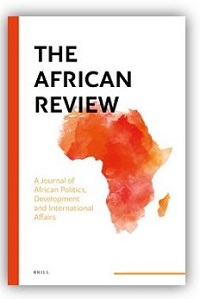The Poverty Demography Trap in Third World Countries: Empirical Evidence from Tanzania
Abstract
This article aims to empirically verify the existence of a poverty-demography trap by analyzing survey data from two regions in northern Tanzania. First, the macro and microeconomic issues on the relation between GDP and population growth are summarized. Poverty and demographic variables in Africa and in Tanzania are also highlighted. The number of Children Everborne (CEB) and household size in the study area indicate a high rate of population growth. Also, the number on non-nuclear household members was found to be about 23%, indicating the impact of population pressure on household resources. The stated demographic variables were classified with selected poverty indicators. The latter include under- and malnutrition, monetary expenditure, access to land, access to clean water, access to sanitary facilities as well as access to energy. Survey results showed a moderate form of under-nutrition and acute malnutrition as being associated with CEB and household size. Large size households tend to spend less on food compared to smaller sized households. The mean weekly expenditure on food among households with six members is a meagre five dollars. As much as 50% of farming households do not own land. Access to clean water, modern toilet facilities, and electricity were found to be very low, especially among large sized households. Besides, as much as fifty percent of households depend on wood for home energy. Even though there was some variation by a rural-urban divide, by migration status, and by type of employment, the overall results show that the study area is within the demography-poverty trap.References
Becker, G. and G. Lewis, 1973, "On the Interaction between Quantity and Quality of Children", JPE, Vol. 81, pp. 25279-5288.
Bloom, D. E. and J. G. Williamson, 1998, "Demographic Transitions and Economic Miracles in Emerging Asia", World Bank Economic Review, Vol.12.
Brass, W. and A. Coale, 1966, The Demography of Tropical Africa (Princeton NJ: Princeton University Press).
Coale, Ansley J., and Edgar M. Hoover, 1958, Population Growth and Economic Development in Low Income Countries (Princeton: Princeton University Press).
Demeney, P. 2003. "Population Policy: A. Concise Summary: Population Council, Policy", Research Division, No. 73.
Humberto, L. and L Serven, 2009, "Too Poor to Grow". Policy Research Working Paper. Report no. WPS5012 Washington DC, The World Bank.
Hyden, G., 1980. Beyond Ujamaa in Tanzania: Under-Development and an Uncaptured Peasantry (London: Heineman).
Kidane, A., 1990, "Mortality Estimates of the 1984-85 Ethiopian Famine", Scandinavian Journal of Social Medicine, Vol. 8, pp. 281-286.
Kidane, A., 1989, "Demographic Consequences of the 1984-85 Ethiopian Famine", Demography, 26, 7, pp. 515-522.
Lanjuow, P. and M. Ravallion, 1995, "Poverty and Household Size", The Economic Journal, 105, 433, pp. 1415-1434.
Leff, N, 1969, "Dependency Rates and Saving Rates", American Economic Review, Vol. 59.
National Bureau of Statistics Tanzania. 2005. "Tanzania Demographic and Health Survey 2004 €“2005". (Dar-es-Salaam: NBS).
Rosenzweig, M. and R. Evinson 1976. "Fertility, Schooling and the Economic Contribution in Rural India: An Economic Analysis", Econometrica, Vol. 44, pp. 1065-1079.
Schultz, T.P., 1990. Introduction to Economic and Demographic Relationships In Development (By Ester Boserup), Edited by T. P Schultz (Baltimore, MD. Johns Hopkins University Press)
Simon, Julian L., 1994, The Ultimate Resource, 2nd edition (Princeton: Princeton University Press).
Tanzania-DHS, 2005, "Demographic and Health Surveys: 2004-5 Final Report" n. 173.
Tanzania €“URT, 2006, "Macroeconomic Policy Framework for the Plan/Budget 2006/7-2008", (Monograph).
Downloads
Published
Issue
Section
License
Copyright © by Department of Political Science and Public Administration, University of Dar es Salaam
All rights reserved. No part of this publication may be reproduced or transmitted in any form or by any means, electronic or mechanical, including photocopying, recording, or any information storage or retrieval system, without permission in writing from the publisher, except for short extracts in fair dealing, for research or private study, critical scholarly review or discourse with an acknowledgement.
The African Review: A Journal of African Politics, Development and International Affairs [ISSN 0856-0056 (Print) & ISSN 1821-889X (Online)] is published bi-annually, June and December by the Department of Political Science and Public Administration, University of Dar es Salaam, P.O. Box 35042 €“ Dar es Salaam €“ Tanzania



